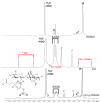Synthesis of Thermoresponsive Chitosan- graft-Poly(N-isopropylacrylamide) Hybrid Copolymer and Its Complexation with DNA
- PMID: 38794509
- PMCID: PMC11124826
- DOI: 10.3390/polym16101315
Synthesis of Thermoresponsive Chitosan- graft-Poly(N-isopropylacrylamide) Hybrid Copolymer and Its Complexation with DNA
Abstract
A hybrid synthetic-natural, thermoresponsive graft copolymer composed of poly(N-isopropyl acrylamide) (PNIPAM) side chains, prepared via RAFT polymerization, and a chitosan (Chit) polysaccharide backbone, was synthesized via radical addition-fragmentation reactions using the "grafting to" technique, in aqueous solution. ATR-FTIR, TGA, polyelectrolyte titrations and 1H NMR spectroscopy were employed in order to validate the Chit-g-PNIPAM copolymer chemical structure. Additionally, 1H NMR spectra and back conductometric titration were utilized to quantify the content of grafted PNIPAM side chains. The resulting graft copolymer contains dual functionality, namely both pH responsive free amino groups, with electrostatic complexation/coordination properties, and thermoresponsive PNIPAM side chains. Particle size measurements via dynamic light scattering (DLS) were used to study the thermoresponsive behavior of the Chit-g-PNIPAM copolymer. Thermal properties examined by TGA showed that, by the grafting modification with PNIPAM, the Chit structure became more thermally stable. The lower critical solution temperature (LCST) of the copolymer solution was determined by DLS measurements at 25-45 °C. Furthermore, dynamic and electrophoretic light scattering measurements demonstrated that the Chit-g-PNIPAM thermoresponsive copolymer is suitable of binding DNA molecules and forms nanosized polyplexes at different amino to phosphate groups ratios, with potential application as gene delivery systems.
Keywords: DNA polyplexes; RAFT polymerization; chitosan; gene delivery systems; grafting; poly(N-isopropylacrylamide); thermal response.
Conflict of interest statement
The authors declare no conflicts of interest.
Figures









References
-
- Wadetwar R.N., Godbole A.P. Nanocarriers: A tool for effective gene delivery. In: Dave V., Gupta N., Sur S., editors. Nanopharmaceutical Advanced Delivery Systems. Scrivener Publishing LLC; Beverly, MA, USA: 2021. pp. 161–185. - DOI
Grants and funding
LinkOut - more resources
Full Text Sources
Other Literature Sources
Miscellaneous

